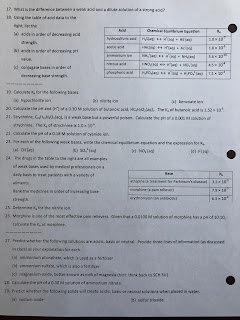Dissociation of Water
H2O(l) ↔
H+(aq) + OH-(aq) very small K
This
process is called the autoionization
of water (1:108 ionized: unionized)
KW
= [H+][OH-] = 1.00 x
10-14 at 25°C
The equilibrium constant, KW, is called the ion product constant. This equation is valid for solutions as well
as, pure water.
- If [H+] > [OH-], solution is acidic
- if [H+] < [OH-], solution is basic
- if [H+] = [OH-], solution is neutral
The Proton in Water
Water
can dissociate to form the hydrogen ion (which is equivalent to a single proton*).
But, when H+ is in solution, its positive charge is attracted
to the negative end of the polar water molecule to form a hydrated hydrogen ion – the
hydronium ion (H3O+).
Since a hydronium ion is simply a hydrated hydrogen ion, we can use the hydronium ion and the hydrogen ion interchangeably in reaction equations.
* A hydrogen atom, H, has 1 proton, 1 electron and 0 neutrons. Thus, the hydrogen ion, H+, has 1 proton, 0 electrons and 0 neutrons.
Arrhenius Acids and Bases
One
the first acid-base definitions (Svante Arrhenius 1859-1927)
“Acids
are substances that, when dissolved in water, increase the hydrogen ion
concentration. Likewise, bases are
substances, that when dissolved in water, increase the hydroxide ion
concentration.”
Acid Properties
- electrolyte (a solute that produces ions in solution – conducts electricity)
- reacts with most metals to form hydrogen gas
- indicators: litmus turns red; bromthymol blue turns yellow; phenolphthalein stays colourless
- tastes sour
Base Properties
- electrolyte (a solute that produces ions in solution – conducts electricity)
- indicators: litmus turns blue; bromthymol blue stays blue; phenolphthalein turns pink
- tastes bitter and feels soapy
Brønsted-Lowry Acids and Bases
"An
acid is a proton donor and a base is a proton acceptor."
Compared to the Arrhenius definition, the Brønsted-Lowry definition allows for a broader range of substances which can be
acidic or basic.
HCl(g) + H2O(l) ↔
H3O+(aq)
+ Cl-(aq)
A B
HNO3(aq) + NH3(g) ↔ NH4+(aq) + NO3-(aq)
A B
Conjugate Acid-Base Pairs
In
any acid-base equilibrium, both the forward and reverse reactions involve
proton transfer.
HNO3(aq) + H2O(l) ↔
NO3-(aq)
+ H3O+(aq)
A B CB CA
↑_________________↑
↑_________________↑
NH3(aq) + H2O(l) ↔
NH4+(aq)
+ OH-(aq)
B A CA CB
↑_________________↑
↑_________________↑
Notice
in these two examples that the acid (A) and its conjugate base (CB) differ by a single
proton. The same can be said for the
base (B) and its conjugate acid (CA).
TryIt!:
Finish the reaction below. Label the acid, base, conjugate acid and conjugate base. Link the related substances across the reaction, like in the example above.
HClO4(aq) + NH3(aq) ↔ ________ + ________
Conjugate Acid-Base Strengths
The
stronger an acid, the weaker its conjugate base; the weaker the acid, the
stronger its conjugate base. This will be important to remember in the coming lessons.
Strong Electrolytes
A
strong electrolyte is a substance which dissolves to produce exclusively ions.
- Some common strong acids: hydrochloric acid, hydrobromic acid, nitric acid, perchloric acid.
- Some common strong bases: all group 1 & 2 metal hydroxides, like sodium hydroxide, barium hydroxide.
HCl(aq)
+ H2O(l) →
H3O+(aq)
+ Cl-(aq)
The above equation can be written in a simplified form as well:
HCl(aq) →
H+(aq)
+ Cl-(aq)
Regardless of whether we write the simplified version of the equation or not, notice that the arrow we use only points in one direction. This is because the acid dissociates 100% in solution. Since
the acid dissociates completely, for every 1 acid molecule that
dissociates, 1 hydrogen (or hydronium) ion ends up in solution.
Weak Electrolytes
A
weak electrolyte is a substance that dissolves to produce ions only to a
limited extent.
- Some common weak acids: acetic acid, lactic acid, benzoic acid, hydrocyanic acid.
- Some common weak bases: all non-group 1 & 2 metal hydroxides, like ammonia.
CH3COOH(aq) + H2O(l) ↔
H3O+(aq)
+ CH3COO-(aq)
The above equation can be written in a simplified form as well:
CH3COOH(aq) ↔
H+(aq)
+ CH3COO-(aq)
Regardless
of whether we write the simplified version of the equation or not,
notice that the arrow we use points in two directions. This is because the acid dissociates less than 100% in solution (in the case of the acetic acid, the amount of dissociation is about 1.6%).
TryIt! Answer:
Homework #1, 4, 5
Answer Keys can be found here.




